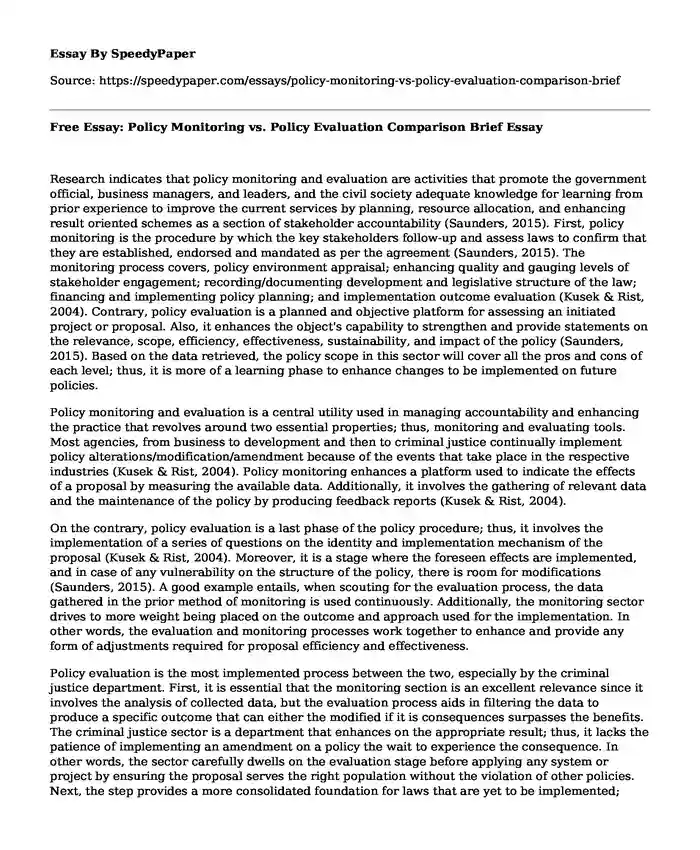
| Type of paper: | Essay |
| Categories: | Policy analysis |
| Pages: | 3 |
| Wordcount: | 619 words |
Research indicates that policy monitoring and evaluation are activities that promote the government official, business managers, and leaders, and the civil society adequate knowledge for learning from prior experience to improve the current services by planning, resource allocation, and enhancing result oriented schemes as a section of stakeholder accountability (Saunders, 2015). First, policy monitoring is the procedure by which the key stakeholders follow-up and assess laws to confirm that they are established, endorsed and mandated as per the agreement (Saunders, 2015). The monitoring process covers, policy environment appraisal; enhancing quality and gauging levels of stakeholder engagement; recording/documenting development and legislative structure of the law; financing and implementing policy planning; and implementation outcome evaluation (Kusek & Rist, 2004). Contrary, policy evaluation is a planned and objective platform for assessing an initiated project or proposal. Also, it enhances the object's capability to strengthen and provide statements on the relevance, scope, efficiency, effectiveness, sustainability, and impact of the policy (Saunders, 2015). Based on the data retrieved, the policy scope in this sector will cover all the pros and cons of each level; thus, it is more of a learning phase to enhance changes to be implemented on future policies.
Policy monitoring and evaluation is a central utility used in managing accountability and enhancing the practice that revolves around two essential properties; thus, monitoring and evaluating tools. Most agencies, from business to development and then to criminal justice continually implement policy alterations/modification/amendment because of the events that take place in the respective industries (Kusek & Rist, 2004). Policy monitoring enhances a platform used to indicate the effects of a proposal by measuring the available data. Additionally, it involves the gathering of relevant data and the maintenance of the policy by producing feedback reports (Kusek & Rist, 2004).
On the contrary, policy evaluation is a last phase of the policy procedure; thus, it involves the implementation of a series of questions on the identity and implementation mechanism of the proposal (Kusek & Rist, 2004). Moreover, it is a stage where the foreseen effects are implemented, and in case of any vulnerability on the structure of the policy, there is room for modifications (Saunders, 2015). A good example entails, when scouting for the evaluation process, the data gathered in the prior method of monitoring is used continuously. Additionally, the monitoring sector drives to more weight being placed on the outcome and approach used for the implementation. In other words, the evaluation and monitoring processes work together to enhance and provide any form of adjustments required for proposal efficiency and effectiveness.
Policy evaluation is the most implemented process between the two, especially by the criminal justice department. First, it is essential that the monitoring section is an excellent relevance since it involves the analysis of collected data, but the evaluation process aids in filtering the data to produce a specific outcome that can either the modified if it is consequences surpasses the benefits. The criminal justice sector is a department that enhances on the appropriate result; thus, it lacks the patience of implementing an amendment on a policy the wait to experience the consequence. In other words, the sector carefully dwells on the evaluation stage before applying any system or project by ensuring the proposal serves the right population without the violation of other policies. Next, the step provides a more consolidated foundation for laws that are yet to be implemented; therefore, the element of feedback enhances on the control mechanisms that can be initiated to limit the consequences, in case the policy faces future potential threats.
References
Kusek, J., & Rist, R. (2004). Ten Steps to a Results-based Monitoring and Evaluation System: A Handbook for Development Practitioners. World Bank Publications.
Saunders, R. (2015). Implementation Monitoring and Process Evaluation. SAGE Publication.
Cite this page
Free Essay: Policy Monitoring vs. Policy Evaluation Comparison Brief. (2022, Sep 28). Retrieved from https://speedypaper.net/essays/policy-monitoring-vs-policy-evaluation-comparison-brief
Request Removal
If you are the original author of this essay and no longer wish to have it published on the SpeedyPaper website, please click below to request its removal:
- Free Example of Critical Analysis Essay on the Article A Difficult Balance of Work and Life
- Creative Writing Essay Example: Obituary for Jesus
- Free Essay Exploring English Grammar
- Essay Example: Political Changes in Texas during the Reconstruction
- 5 Mic Project
- Literature Review on Global Leadership
- Situational Awareness of Speeding. Free Essay
Popular categories




